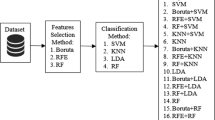Abstract
This paper proposes a new method to classify remote sensing data by using Particle Swarm Optimization (PSO). This method is to generate classification rules through simulating the behaviors of bird flocking. Optimized intervals of each band are found by particles in multi-dimension space, linked with land use types for forming classification rules. Compared with other rule induction techniques (e.g. See5.0), PSO can efficiently find optimized cut points of each band, and have good convergence in the search process. This method has been applied to the classification of remote sensing data in Panyu district of Guangzhou with satisfactory results. It can produce higher accuracy in the classification than the See5.0 decision tree model.
Similar content being viewed by others
References
Wilkinsom G G. Results and implications of a study of Fifteen years of satellite image classification experiments. IEEE T Geosci Remote Sens, 2005, 43(3): 433–440
Strahler A H. The use of prior probabilities in maximum likelihood classification of remotely sensed data. Remote Sens Environ, 1980, 10: 135–163
Aksoy S, Koperski K, Tusk C, et al. Learning Bayesian classifiers for scene classification with a visual grammar. IEEE T Geosci Remote Sens, 2005, 43(3): 581–589
Wilkinsom G G. A Review of Current issue in the integration of GIS and Remote sensing data. Int J Geogr Inf Sci, 1996, 10(1): 85–101
Pal M, Mather P M. An assessment of the effectiveness of decision tree methods for land cover classification. Remote Sens Environ, 2003, 86: 554–565
Friedl M A, Brodley C E. Decision tree classification of land cover from remotely sensed data. Remote Sens Environ, 1997, 61: 399–409
Huang C, Davis L S, Townshend J R G. An assessment of support vector machines for land cover classification. Int J Remote Sens, 2002, 23: 725–749
Melgani F, Bruzzone L. Classification of hyperspectral remote sensing images with support vector machines. IEEE T Geosci Remote Sens, 2004, 42: 1778–1790
Frizzelle B G, Moody A. Mapping continuous distributions of land cover: A comparison of maximum-likelihood estimation and artificial neural networks. Photogramm Eng Remote Sens, 2001, 67(6): 693–705
Heerman P D, Khazenie N. Classification of multispectral remote sensing data using a back propagation neural network. IEEE T Geosci Remote Sens, 1992, 30(1): 81–88
Wang F. Fuzzy supervised classification of remote sensing images. IEEE T Geosci Remote Sens, 1990, 28(2): 194–201
Bandyopadhyay S, Pal S. Pixel classification using variable string genetic algorithms with chromosome differentiation. IEEE T Geosci Remote Sens, 2001, 39(2): 303–308
Foody G M, Mathur A. A relative evaluation of multi class image classification by support vector machines. IEEE T Geosci Remote Sens, 2004, 42(6): 1335–1343
Stathakis D, Vasilakos A. Comparison of computational intelligence based classification techniques for remotely sensed optical image classification. IEEE T Geosci Remote Sens, 2006, 44(8): 2305–2318
Machado Th R, Lopes H S. A Hybrid Particle Swarm Optimization Model for the Traveling Salesman Problem. Adaptive and Natural Computing Algorithm. New York: Springer, 2005. 255–258
Kennedy J. Stereotyping: improving particle swarm performance with cluster analysis. In: Proceedings of the Congress on Evolutionary Computing. Piscataway: IEEE Service Center, 2000. 1507–1512
Ting T O, Rao M V C, Loo C K, et al. Solving unit commitment problem using hybrid particle swarm optimization. J Heuristics, 2003, 9(6): 507–520
Kwang M S, Weng H S. Multiple ant-colony optimization for network routing. In: Proceedings of the First International Symposium on Cyber Worlds. 2002. 277–281
Liu X P, Li X, Yeh A G O, et al. Discovery of transition rules for geographical cellular automata by using ant colony optimization. Sci China Ser D-Earth Sci, 2007, 50(10): 1578–1588
Omran M. Particle Swarm Optimization methods for pattern Recognition and Image Processing. Dissertation for the Doctoral Degree. University of Pretoria, 2005
Kennedy J, Eberhart R C. Particle swarm Optimization. In: Proc. IEEE, International Conference on Neural Networks. Piscataway. New Jersey. 1995. 1942–1948
Kennedy J, Eberhart R C, Shi Y. Swarm Intelligence. San Francisco: Morgan Kaufman Publishers, 2001
Sousa T, Neves A, Silva A. A particle swarm data miner. In: 11th Portuguese Conference on Artificial Intelligence, Workshop on Artificial Life and Evolutionary Algorithms, 2003, 43–53
Liu Y, Qin Z, Shi Z W, et al. Rule discovery with particle swarm optimization. Lect Notes Comput Sci, 2004, 291–296
Shi Y H, Eberhart R C. Parameter selection in particle swarm optimization. The Seventh Annual Conference on Evolutionary Programming. Washington DC. 1998. 591–600
Congalton R G. A review of assessing the accuracy of classification of remotely sensed data. Remote Sens Environ, 1991, 37: 35–46
Author information
Authors and Affiliations
Corresponding authors
Additional information
Supported by the National Outstanding Youth Foundation of China (Grant No. 40525002), the National Natural Science Foundation of China (Grant No. 40471105), and the Hi-tech Research and Development Program of China (863 Program) (Grant No. 2006AA12Z206).
Rights and permissions
About this article
Cite this article
Liu, X., Li, X., Peng, X. et al. Swarm intelligence for classification of remote sensing data. Sci. China Ser. D-Earth Sci. 51, 79–87 (2008). https://doi.org/10.1007/s11430-007-0133-6
Received:
Accepted:
Issue Date:
DOI: https://doi.org/10.1007/s11430-007-0133-6




